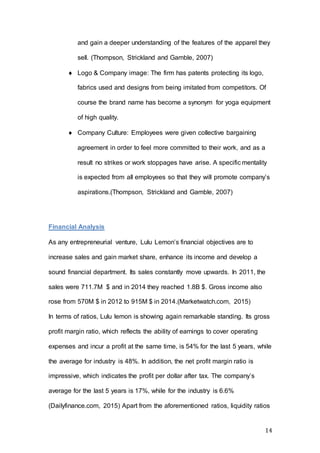Lulu Lemon is a designer and retailer of athletic apparel focused on yoga. It has 254 stores worldwide and was founded in 1998 in Vancouver. The document analyzes Lulu Lemon's strategy through examining its external environment using PESTEL and Porter's Five Forces analyses, and internal environment through assessing its resources, capabilities, competencies, and financial performance. It identifies key success factors and front burner issues for the company. The summary provides a high-level overview of the company, the strategic analysis tools used, and the areas assessed in the internal/external analyses.

























![26
REFERENCES
Armstrong, G. and Kotler, P. (2000). Marketing. Upper Saddle River,
NJ: Prentice Hall.
Blair, W. (2013). Lululemon Athletica. 1st ed. [ebook] Available at:
http://files.shareholder.com/downloads/LULU/0x0x671550/3b94aaef-
8795-4249-bad6-
8de9aca56093/William_Blair_presentation_June_2013.pdf [Accessed
15 Apr. 2015].
Booth, T. (2013). 11 Rules For Great UX Design, Adapted From An
Original Mad Man. [online] Co.Design. Available at:
http://www.fastcodesign.com/1672597/11-rules-for-great-ux-design-
adapted-from-an-original-mad-man [Accessed 15 Apr. 2015].
Dailyfinance.com, (2015). Lululemon Athletica Financial Ratios LULU |
DailyFinance. [online] Available at:
http://www.dailyfinance.com/quote/nasdaq/lululemon-
athletica/lulu/financial-ratios [Accessed 16 Apr. 2015].
Helliker, K. (2010). Lululemon Grows Fast on a Slim Budget. Wall
Street Journal. [online] Available at:
http://www.wsj.com/articles/SB10001424052748703960004575481890
366935552 [Accessed 15 Apr. 2015].
inc, l., Feud, L., Strife, H., Sales, L., Trend, J., Fans, L., Gym Clothes
That Don't Stink, T., Own, N., Retail, H. and Cred, H. (2015).
LULULEMON ATHLETICA INC (LULU:Consolidated Issue Listed on
NASDAQ Global Select ): Stock Quote & Company Profile -
Businessweek. [online] Businessweek.com. Available at:](https://image.slidesharecdn.com/7675bba9-78c2-451a-bb63-5ecb1fb89e01-151001092402-lva1-app6892/85/BS_PAPER-26-320.jpg)
![27
http://www.bloomberg.com/research/stocks/snapshot/snapshot.asp?tic
ker=LULU [Accessed 14 Apr. 2015].
Investor.lululemon.com, (2015). corporate governance | lululemon
athletica, inc.. [online] Available at:
http://investor.lululemon.com/governance.cfm [Accessed 14 Apr. 2015].
Lululemon.com, (2015). yoga clothes & running gear for sweaty
workouts | lululemon athletica. [Online] Available at:
http://www.lululemon.com [Accessed 14 Apr. 2015].
Manufacturingmap.nikeinc.com, (2015). Nike Sustainability - Interactive
Map. [online] Available at: http://manufacturingmap.nikeinc.com/#
[Accessed 15 Apr. 2015].
Marketwatch.com, (2015). lululemon athletica inc.. [online] Available at:
http://www.marketwatch.com/investing/stock/lulu/financials [Accessed
16 Apr. 2015].
Moran, A. (2013). From rooms to retreats – Yoga becomes multi-
billion-dollar industry. [online] Examiner.com. Available at:
http://www.examiner.com/article/from-rooms-to-retreats-yoga-
becomes-multi-billion-dollar-industry [Accessed 15 Apr. 2015].
Pacheco, H. (2013). Design patents and Lululemon: a way forward in
fashion? | Lexology. [online] Lexology.com. Available at:
http://www.lexology.com/library/detail.aspx?g=a618791e-3967-4e4f-
a24f-76ca37c397f7 [Accessed 15 Apr. 2015].
Porter, M. (1997). COMPETITIVE STRATEGY. Measuring Business
Excellence, 1(2), pp.12-17.](https://image.slidesharecdn.com/7675bba9-78c2-451a-bb63-5ecb1fb89e01-151001092402-lva1-app6892/85/BS_PAPER-27-320.jpg)
![28
Reuters.com, (2015). Lulu lemon Athletica Inc. (LULU.O) Company
Profile | Reuters.com. [Online] Available at:
http://www.reuters.com/finance/stocks/companyProfile?
Symbol=LULU.O [Accessed 14 Apr. 2015].
Road Less Invested. (2012). Lululemon Athletica Inc.: Information
package. Retrieved from
http://www.roadlessinvested.com/uploads/8/7/6/1/8761673/_____lulule
mon_athletica_inc._ 11-16-2012_-_beta_test.pdf
Thompson, A., Strickland, A. and Gamble, J. (2007). Crafting and
executing strategy. (19th ed) Boston: McGraw-Hill/Irwin.
US Census Bureau, (2015). Annual Retail Trade Survey. [online]
Available at: http://www.census.gov/services/ [Accessed 15 Apr. 2015].](https://image.slidesharecdn.com/7675bba9-78c2-451a-bb63-5ecb1fb89e01-151001092402-lva1-app6892/85/BS_PAPER-28-320.jpg)